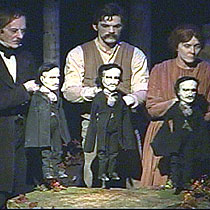2007年VOA标准英语-Puppetry Theater for Adults Thrives In Atlanta(在线收听)
Atlanta, Georgia
15 May 2007
At the Center for Puppetry Arts in Atlanta, in the southern state of Georgia, children and adults come together to enjoy the centuries-old art of puppetry. For more than 28 years, the Center has preserved and expanded puppetry as an art form, and was called by Newsweek magazine as "one of the most exciting companies in American theater." For producer Roger Hsu, Jim Bertel has the story.
Edgar Allan Poe's "The Tell-Tale Heart" is a story of murder and paranoia, not your typical puppet fare. But it demonstrates the wide range of productions produced by the Center for Puppetry Arts.
Bobby Box is the producer of the show. "So much of the show is about repression, about taking your feelings and burying it inside of you. With puppets there is no facial movement, because their faces never move, their heads move, their bodies move, but because their faces never move, it suggests something deep down inside is just boiling away," he says.
The Center's education program director, Alan Louis, says puppets are not only for children. "I don't know what people think of when they think of puppets, maybe they think of something very simple, silly, but when they come and see a large production like (this), it's theater, instead of an actress, there are objects manipulated on stage."
 |
| Puppets and puppeteers |
"When you say ‘adult puppet theater,’ maybe they get a little bit nervous,” says Louis. “They think, ‘Oh, is it X-rated?’ No, it's just theater for adults, you wouldn't bring a child because he would be bored -- wouldn't understand the content."
Audience members at the show like the more mature approach to puppetry. "I was expecting it to be a lot more childish, I guess. It's really dark and graphic," thought one woman.
"The experience is very much like coming to an actual theater play, people think of it as a child's play but in truth they make it for adults," said a male theatergoer.
"The fact that there were human beings manipulating the puppets just enhances it." "I thought it was going to be where you part the curtains and the puppets come up, this was so different," added two other members of an audience.
Opened to the public in 1978, the Center for Puppetry Arts has been described as a unique cultural treasure. It boasts a puppet museum housing some 1000 puppets collected from around the world.
One of the puppeteers explains the four different styles of puppetry. "Hand puppet: your hand goes inside the puppet and controls it like this – ‘Hello, I am a hand puppet.’ Usually shadow puppets are performed on a big white screen. Again you would have the arm rods so you can control the puppets. There is a rod that controls his head from here and also two arm rods that control his arms so he can dance. A string puppet is also known as a marionette. Different strings go to different parts of the body. So if you take this off and make his feet move for the click you walk in."
The Center's mission is more than just entertaining audiences. Box says it also hopes to nurture and expand the puppetry art form, and explore the past, present and future of puppetry. "When puppetry doesn't move forward, it gets lost in the back. Sometimes people look at my work and say that's not puppetry. You know puppets are – you can't see the puppeteers – or puppets should be silly, they should be this, they should be that and you can't do that with the puppet. Of course, our response is, 'Why not?' In fact my response is, 'You have to’," he adds.